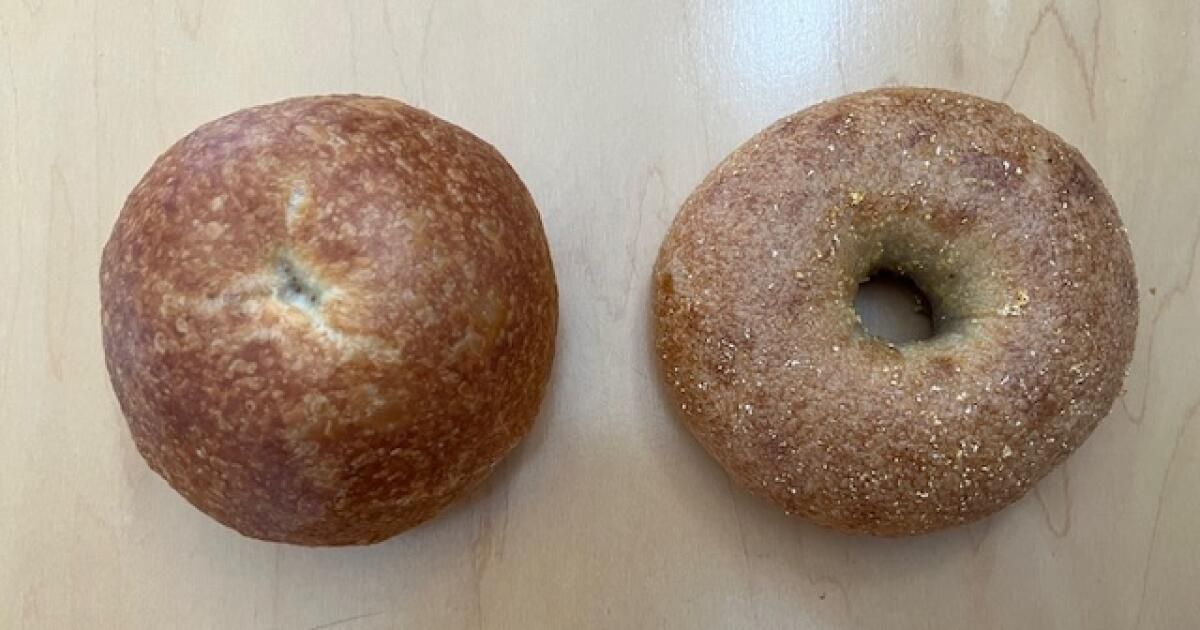Bagels are under siege, and if you need proof, I offer one word: Airy.
Bagels, which have always been synonymous with chewy, have recently been described (approvally) as airy on both coasts and in Canada.
Also, fluffy.
And because they are, they risk losing another defining characteristic, along with chewing. Some of them – not all, but some – no longer have a hole in the center, which raises the existential question: when does a hole in the center appear? donut Stop being a bun and become another type of bread?
Apparently not yet, given the flatterer coverage of what could become the new normal.
I'm eyeing a fluffy specimen at a neighborhood bagel place so popular I passed by several times looking for a window when there weren't 20 people in line. It was impossible to have reasonable breakfast and brunch times, so one morning I showed up at the door five minutes after the place opened, when there were only three people in front of me.
Finally, I considered my prize. It had a suspiciously domed profile, unlike the real model, which looks more like a hockey puck. The apex of the dome bounced when I pressed it, a yeasty little trampoline. It must be all that lightness trapped inside, I thought.
And he was trapped, because this bun had no hole. It had a dimple, but I couldn't get through the crack to get to the other side. You can't twist this type of bagel on your finger, not that you would, but you should be able to, if it lived up to its name.
Do not misunderstand. My breakfast order was delicious; Not only was it airy, almost elevated, but it was also sourdough, very strong. I'd gladly make a sandwich with it, maybe even deflate her loft into a bagel/panini hybrid. It could be croutons once it's stale. I would buy it again.
But it's not a muffin. Soft, without holes: it is the end of the world as we know it. And I do not feel well.
I'm not being nostalgic here. There are practical reasons for the texture and hole of a bagel. The dense structure supports toppings in a way that softer, lighter bagels don't. And the hole means more surface area, which means no soggy center and more crust per bite. Lightness alters the very DNA of the bagel and, in the long term, its identity. Enough of these airy products and we might start to think that a real bagel isn't real.
In recent years there has been an ongoing debate about culinary culture. appropriation, based on a story of white chefs taking over ethnic kitchens, putting ethnic chefs at a disadvantage in what is already a fiercely competitive profession. This is not that; The bakers behind the new bagel are a diverse group, some with Eastern European roots, like the bagel itself, and some not. They talk about the “Los Angeles roscón”, a proud mix of then and now, testimony to the cuisine of the city without borders.
And while I'm still keeping an eye on the trend, at least it's a product of creative innovation. The ominous cloud on the bagel horizon is cast by none other than Philadelphia Cream Cheese, the long-running other half of “bagel and schmear,” which has launched Philly Bagel Wholes in partnership with bagel bakers across the country and in Canada , an equally dimpled business, if more so. Article similar to a record whose slogan is: “Now there is more room for Philadelphia.” More surface area requires more cream cheese; inspiration, here, is the final result.
I would like to suggest so bakers and bagel fans can have it all, preserve the old and celebrate the new. Eleven years ago, New York pastry chef Dominique Ansel announced the birth of the cronut, a trademarked combination of croissant and donut that replaced neither; it was his own new entity. He wasn't muddying the waters, just paddling further, toward a unique cake with a unique name.
We can do that too – I agree that whatever was in front of me was not a bagel, and I market its distinctive identity in a way that doesn't nullify its heritage. In my family, we refer to puffed bagel variants as “a brioche disguised as a bagel,” which seems like a promising starting point. We can create a mashup. We can update the terminology.
Order a briogel with schmear. Order a bagoche of everything. But leave the bun alone.
Karen Stabiner's most recent book is “Generation Chef: Risking Everything for a New American Dream.”












